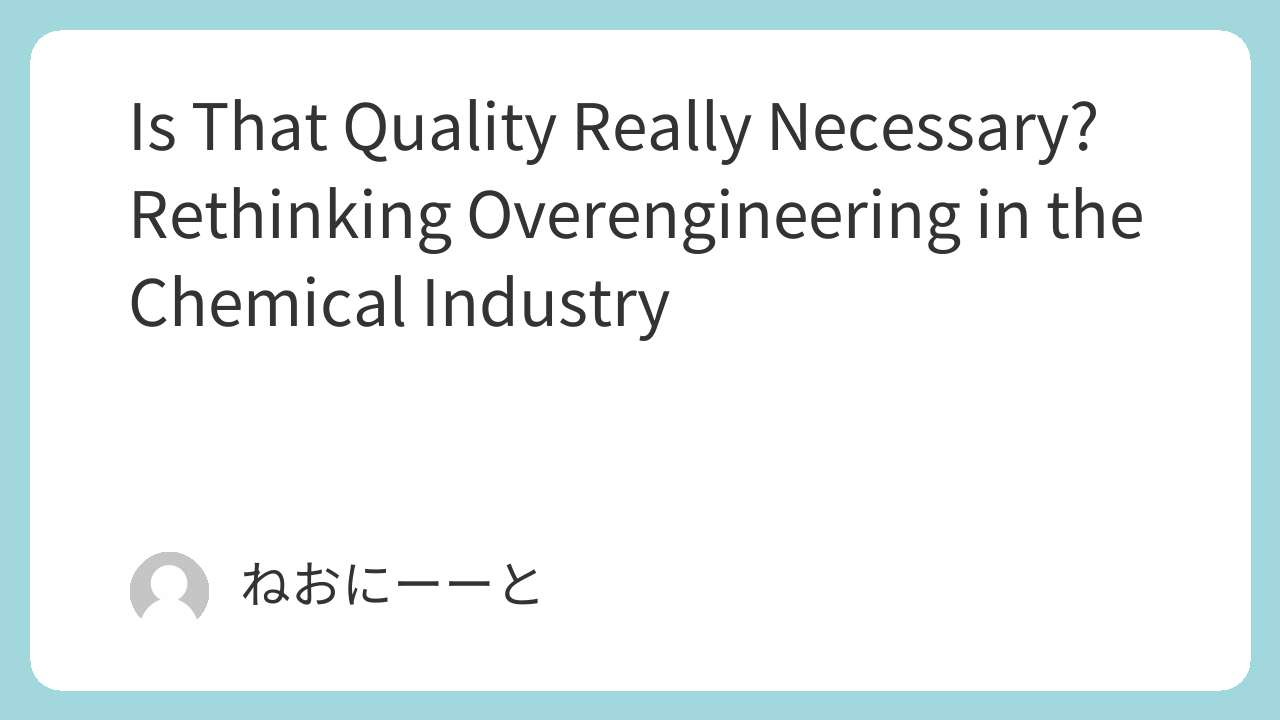Japan is renowned for its manufacturing quality. But even in highly trusted industries like chemicals, we are increasingly witnessing problems rooted in overquality—doing more than what’s realistically needed. While aiming for perfection might feel safe, it can often lead to inefficiencies, unnecessary costs, and decision paralysis.
In this article, we’ll explore how “too much quality” can harm productivity in chemical plants, drawing from real-world examples and systemic issues in raw material specs, equipment, and inspection practices.
- 1. Excessively Strict Raw Material Specifications
- 2. PSS and CoA Aren’t Enough
- 3. Once Set, Specs Never Change
- 4. Unproven Product Specs
- 5. Rework Without Backup Lines
- 6. Over-Cleaning Processes
- 7. Unknown Impact of Impurities
- 8. Equipment Specifications Lacking Justification
- 9. Overly Strict Construction Standards
- ✅ Conclusion:
1. Excessively Strict Raw Material Specifications
Chemical products begin with raw materials. But many companies define unnecessarily tight specs for appearance, content, and impurities—sometimes stricter than necessary for end-product performance.
Suppliers struggle to meet these demands, often having to split production lines into “standard” and “custom” grades, causing inefficiencies and delivery delays.
2. PSS and CoA Aren’t Enough
Even if a material meets contract specs and comes with a valid Certificate of Analysis (CoA), users may still demand PSS (Pre-Shipment Samples) and in-house testing.
This happens especially in GMP environments where even minor suspicions result in product rejection, creating extra burdens for suppliers.
3. Once Set, Specs Never Change
Changing raw material specifications is almost taboo. Once a spec is proven achievable, there’s often a belief that another supplier can match it—even if the original stops producing it. This mindset locks companies into outdated standards, even at high cost.
4. Unproven Product Specs
Even if high-quality products are manufactured under tight control, their specs may have little verified impact on performance. No one questions whether these specs matter—they simply persist.
5. Rework Without Backup Lines
When off-spec products are discovered, plants often have no dedicated rework line. As a result, they must use regular lines for reprocessing, disrupting normal operations and causing scheduling headaches.
6. Over-Cleaning Processes
From excessive flushing of pipelines to redundant washing after phase separations, cleaning is often performed “just in case.” Yet these steps are rarely quantitatively evaluated. Costs related to solvent use, waste treatment, and time are often ignored.
7. Unknown Impact of Impurities
Even for trace impurities, neither manufacturers nor clients may understand their actual impact. Without testing or customer feedback, specs are locked in to minimize perceived risk—regardless of cost.
8. Equipment Specifications Lacking Justification
From unnecessary polishing of metal surfaces to choosing exotic materials like Hastelloy without corrosion data, equipment specs often reflect fear of failure more than engineering need. Long-term wear and degradation raise further questions.
9. Overly Strict Construction Standards
Construction practices may demand perfection in weld appearance, dimension tolerances, or pipe segregation—far beyond industry norms. While the intentions are good, this can lead to strained vendor relationships and higher costs, without adding real value.
✅ Conclusion:
In the chemical industry, “better safe than sorry” is a deeply embedded mindset—but sometimes that caution goes too far. Overquality, though rooted in good intentions, can lead to inflexibility, wasted resources, and stagnant innovation. It’s time to step back and ask: Is this level of quality really necessary? By questioning long-standing assumptions, companies can maintain safety and performance while improving efficiency.

Comments